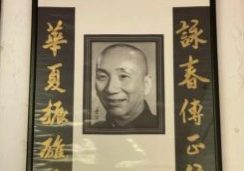Wing Chun Kung Fu
Martial Art
Wing Chun Kung Fu is considered one of the most effective forms of unarmed combat known and practised throughout the world. The Wing Chun system is approximately 400 years old and was created by a Buddhist Nun named Ng Mui.
Wing Chun’s female creator took note of physical differences between men and women, therefore the emphasis is not upon force & strength to succeed, but the use of skillful hand and footwork combined with speed & technique to overcome opposition in the shortest possible time!
Wing Chun History
Ng Mui
During the reign of Emperor K’anghsi ( 1662-1722 ) a Buddhist nun named Ng Mui fled the burning of the Shaolin monastery of Mt. Sung in the Honan province of China, along with Abbot Chi Shin, Abbot Pak Mei, Master Fung To Tak and Master Miu Hin, each went their separate ways to avoid capture by the Manchu government who were responsible for the attack. Ng Mui took refuge and reflected upon the style of Martial Arts she had learnt and realised that it could be improved upon as a practical fighting system, particularly for a woman. It is said that she was out walking one day and witnessed a fight between a crane and a snake and she adopted the principals and concepts that she saw and developed a fighting style based upon the human skeletal and muscular framework that focused on practicality and effectiveness.
Yim Wing Chun
It was during this time that she came to know Mr.Yim Yee who owned a store where Ng Mui bought bean curds. Mr. Yim Yee had a beautiful young daughter, Yim Wing Chun who was betrothed to Leung Bok Chau, a salt merchant of Fukien, however Yim Wing Chun’s beauty had attracted the unwanted attention of a local warlord who made known his intentions to marry her forcibly if necessary. Ng Mui learnt of the situation and took pity on Yim Wing Chun and agreed to teach her this newly developed fighting system so that she could protect herself. Yim Wing Chun went to the mountains with Ng Mui and trained night and day to master the techniques and then she returned to her village and challenged the warlord to open hand combat, which she won, and was then free to marry her intended husband. Ng Mui then left to travel the country, but before she left she told Yim Wing Chun to honour the Kung Fu traditions and develop her Kung Fu after her marriage. Once married Wing Chun taught her Kung Fu skills to her husband, Leung Bok Chau, who named the system ” Wing Chun ” in reverence to his wife.
Wong Wah Bo/Leung Yee Tai
Leung Bok Chau taught Wing Chun to Leung Lan Kwai, a herbalist who took a student Wong Wah Bo. He was a member of an opera troupe on board a junk, known to the Chinese as the ‘red junk’. Also on board was Leung Yee Tei who had been taught the six-and-a-half point long pole techniques by Abbot Chi Shin. Wong Wah Bo and Leung Yee Tei became close friends and they shared their knowledge of the martial arts, together they correlated and refined their techniques and so the six-and-a-half long pole techniques became incorporated in Wing Chun. Leung Yee Tei passed his martial art skills on to Leung Jan, a well-known herbal doctor in Fat Shan in the Kwangtung province.
Leung Jan
Leung Jan grasped the innermost secrets of Wing Chun and attained the highest level of proficiency and skill. Many Kung Fu masters came to challenge him, but all were defeated and soon Leung Jan became very famous. Leung Jan had two sons, Leung Bik and Leung Cheun, both of whom were taught Wing Chun daily, he also took one other student Chan Wah Shan.
Chan Wah Shan
Chan Wah Shan taught only sixteen disciples over thirty six years, including Ng Siu Lo, Ng Chung So, Chan Yu Min and Lui Yu Jai. The last of Chan Wah Shan’s students was Yip Man, who began training Wing Chun in 1901 at the age of seven. Before Chan Wah Shan died he asked his senior student Ng Chung So to continue teaching the young Yip Man.
Grand Master Yip Man
(1893-1972)

Yip Man continued his training until he was fifteen when he went to Hong Kong to pursue his academic studies at the St.Stephen’s College. It was whilst he was there that he met and subsequently began training with Leung Bik, the eldest son of Grandmaster Leung Jan. During the war Yip Man served in the army and afterwards returned to China to take up the post of “Captain of Local Police Patrols of Namhoi”, however in 1949 when mainland China fell into the hands of the communists Yip Man fled his home to settle in Hong Kong.
In May 1950 Yip Man began teaching Wing Chun full time at the Restaurant Workers Union Hall, and from that small initial class Grandmaster Yip Man is reputed to have taught many thousands of students over twenty three years of teaching.
(1972-onwards)
Grandmaster Yip passed away on 2nd December 1972 aged 79. Following his death Wing Chun continued to be taught in Hong Kong and later outside Hong Kong by the Grandmaster’s students.
Today Wing Chun is being actively taught around the world we are proud to be a part of that family and its lineage.
